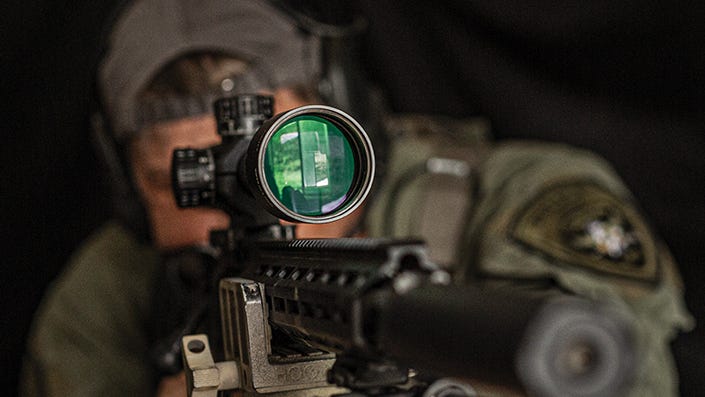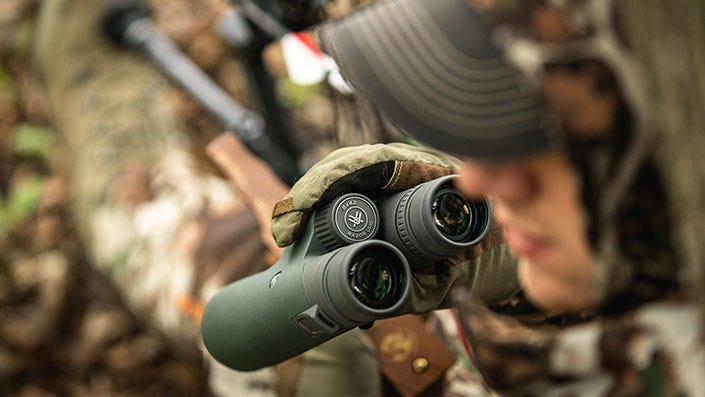What Makes Great Low-light Performance?
The optical system design, lens design, and coatings on the lenses are what determine how good an optic is in low light. Pretty simple, right? Well, not necessarily. There’s a lot of information and misinformation out there about what makes an optic work well in low light, and we’re here to shine a little light on the subject.

Objective lens diameter isn’t that important
First, let’s get this out of the way: Objective lens diameter has something to do with it, but is not the most important aspect. Too many people will tell you the objective lens is basically the only thing that matters, but they're only saying that because it's the only thing they can see and the only lens in the system that's given its own number in the scope’s name (like a 4-16x50). That "50" is referring to the objective lens diameter. What you don't see is a bunch of other numbers behind that "50" about the 5, 10, maybe even 15 other lenses behind that one! All are very important; you can shove as much light as you want down the bell of a scope with a massive objective, but if all the lenses behind it can't handle it, the image will still be disappointing.
A word or three on coatings
Most people just kind of blow off optical coatings and want to talk about the glass or lens size, but there are countless chemical makeups of coatings and it really is like an art form for optical engineers to not only develop the lenses and optical system in a scope, but also determine the best recipe of anti-reflective coatings to keep the wrong light out of the scope and keep the best light flowing through the lenses, to your eye.

It’s also more complicated than it looks. Not only are the chemical compositions of lens coatings different, there are actually different ways of coating a lens. For example: You might hear about coated, fully coated and fully multi-coated lenses. In general, different manufacturers can use these terms a little differently, but in the end, “fully multicoated” usually means that all surface-to-air glass is coated, and that’s ideal. You will likely pay more for such coatings, but if you demand low-light performance, “fully multicoated” is more likely to get you the optical experience you’re looking for.
Objective lens diameter is important

It isn't completely a moot point
If you took the same exact riflescope and changed nothing else other than making the objective lens bigger, you would be allowing more light into the scope and probably most importantly - improving your exit pupil. Exit pupil most of the time can be calculated by dividing the objective lens diameter by whatever magnification you're on. A 50mm bell on a riflescope set at 10x will have a 5mm exit pupil.
As our adult eyes age, the ability for the pupil to dilate in darkness becomes less and less, and our pupils may only be able to dilate 4-6mm, so there's a chance some of the exit pupil from a riflescope like that might even be wasted as it's not even making it through your pupil.
The point here remains, though: Your optic will always perform better in low light on a lower magnification, as the exit pupil will increase to maximize the ability of your eye to take in as much light as possible.

When it comes to low-light performance, optical design and quality of lenses and coatings is most important. A higher end optical system with a relatively smaller objective bell will almost always trump a lower-end optic with a giant objective. Objective bell size does affect exit pupil, but your eye can only suck in so much light, even in the dark as it dilates and your pupils become larger. Lowering your magnification will also help greatly in low-light scenarios.
In general, when you spend more on an optic, one of the things you’re spending more on are better lens coatings and better glass, and that can matter way more than a bigger objective lens.
Can’t get enough on optical design? Check out these podcasts on everything you ever wanted to know about binoculars and everything you ever wanted to know about riflescopes.
It’s our hope you can learn and laugh along with the expert voices we feature on this blog. We want to be clear that the opinions you see featured here are just that: opinions. The content belongs to the authors and is not necessarily the opinion of Vortex Optics.
To learn more about what you’ve read, please like, follow, and otherwise support our authors.





